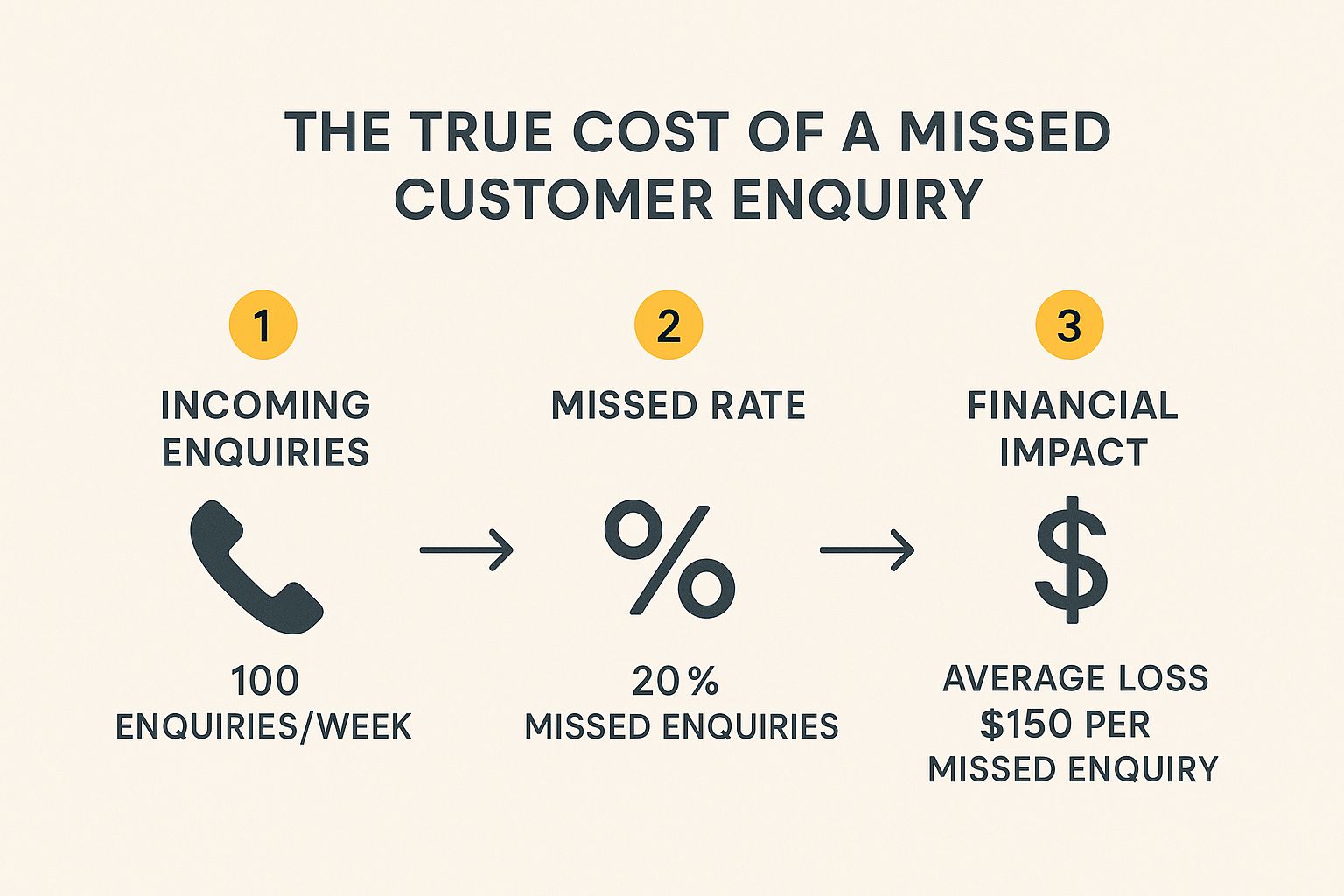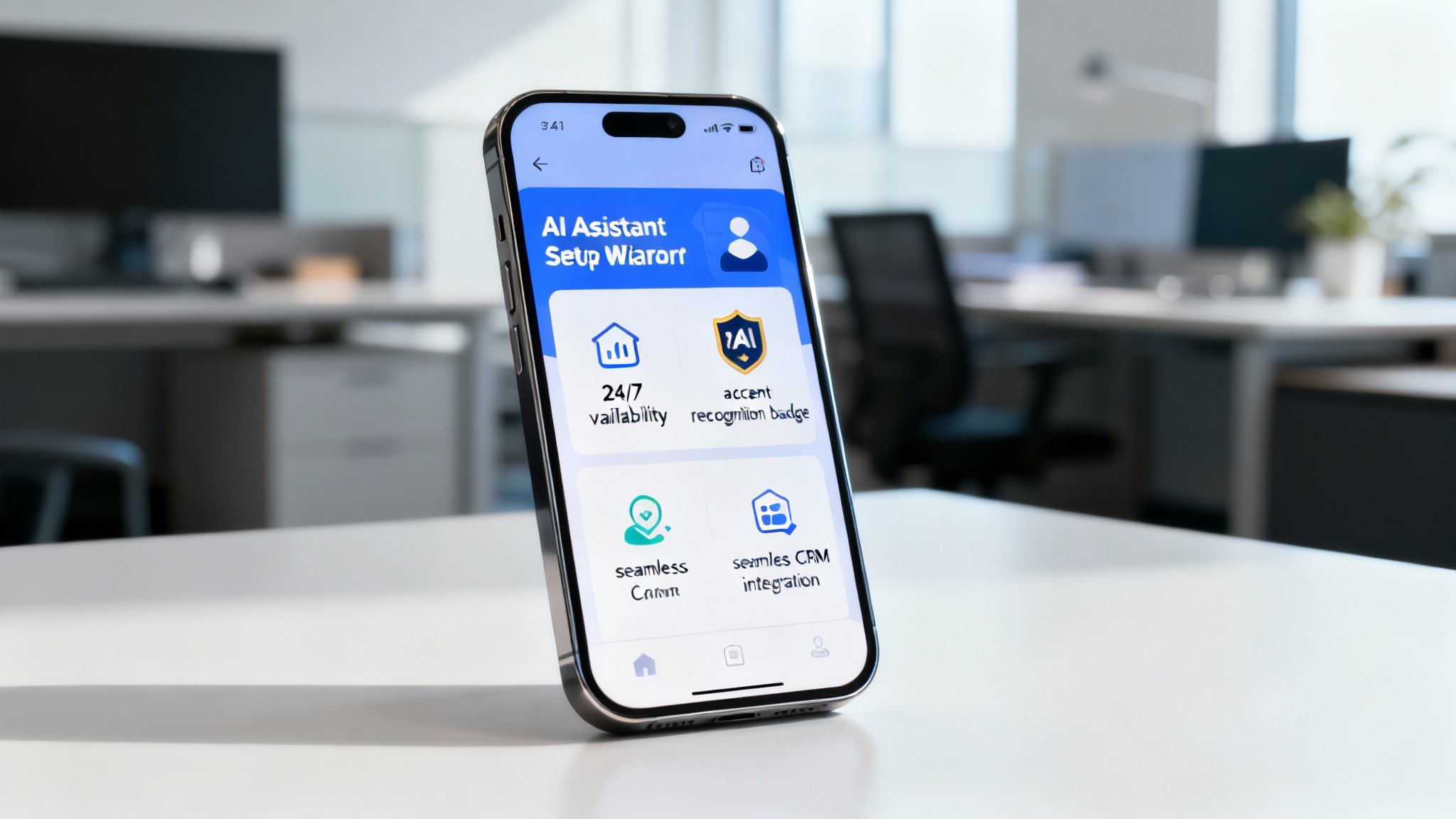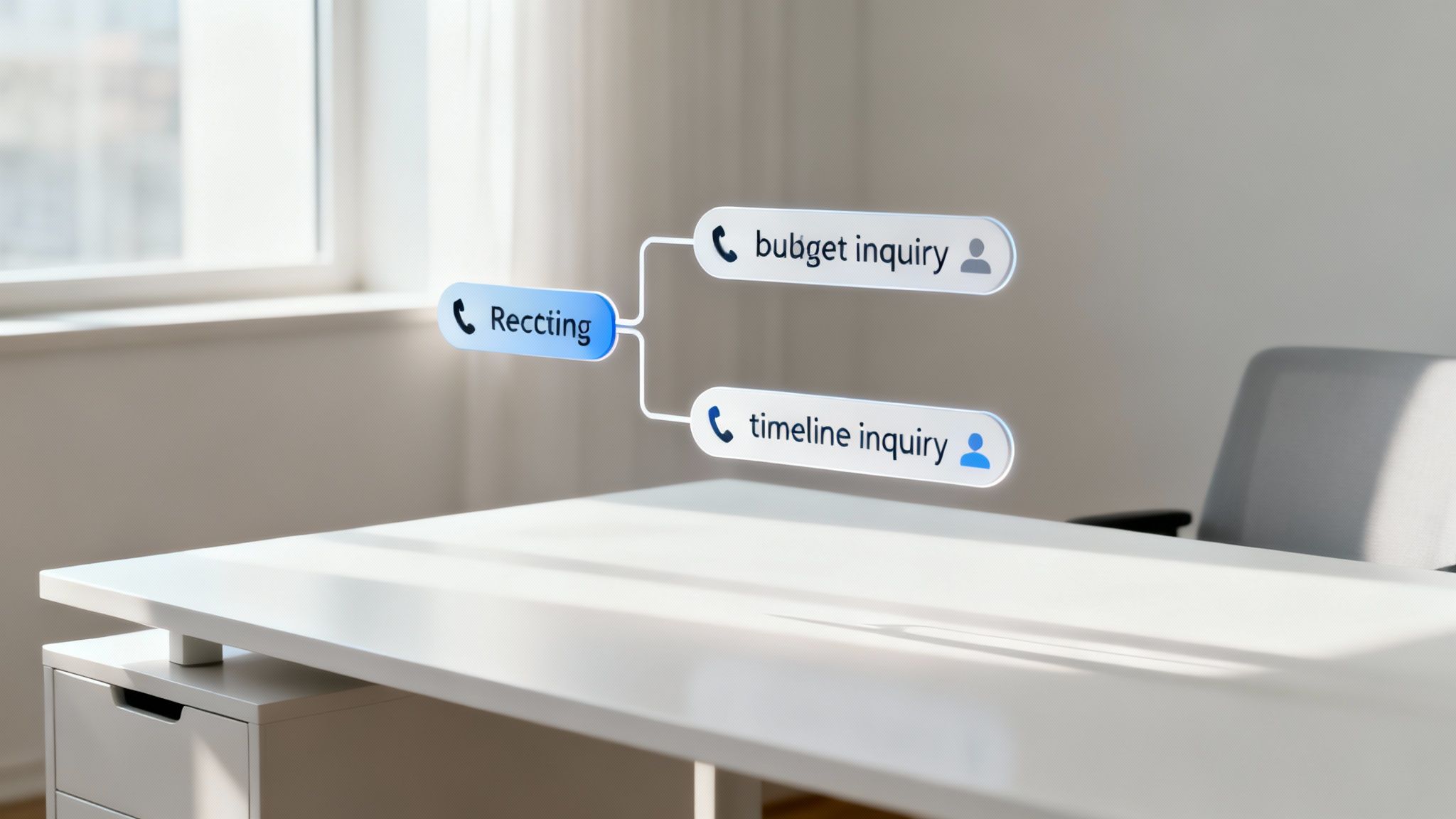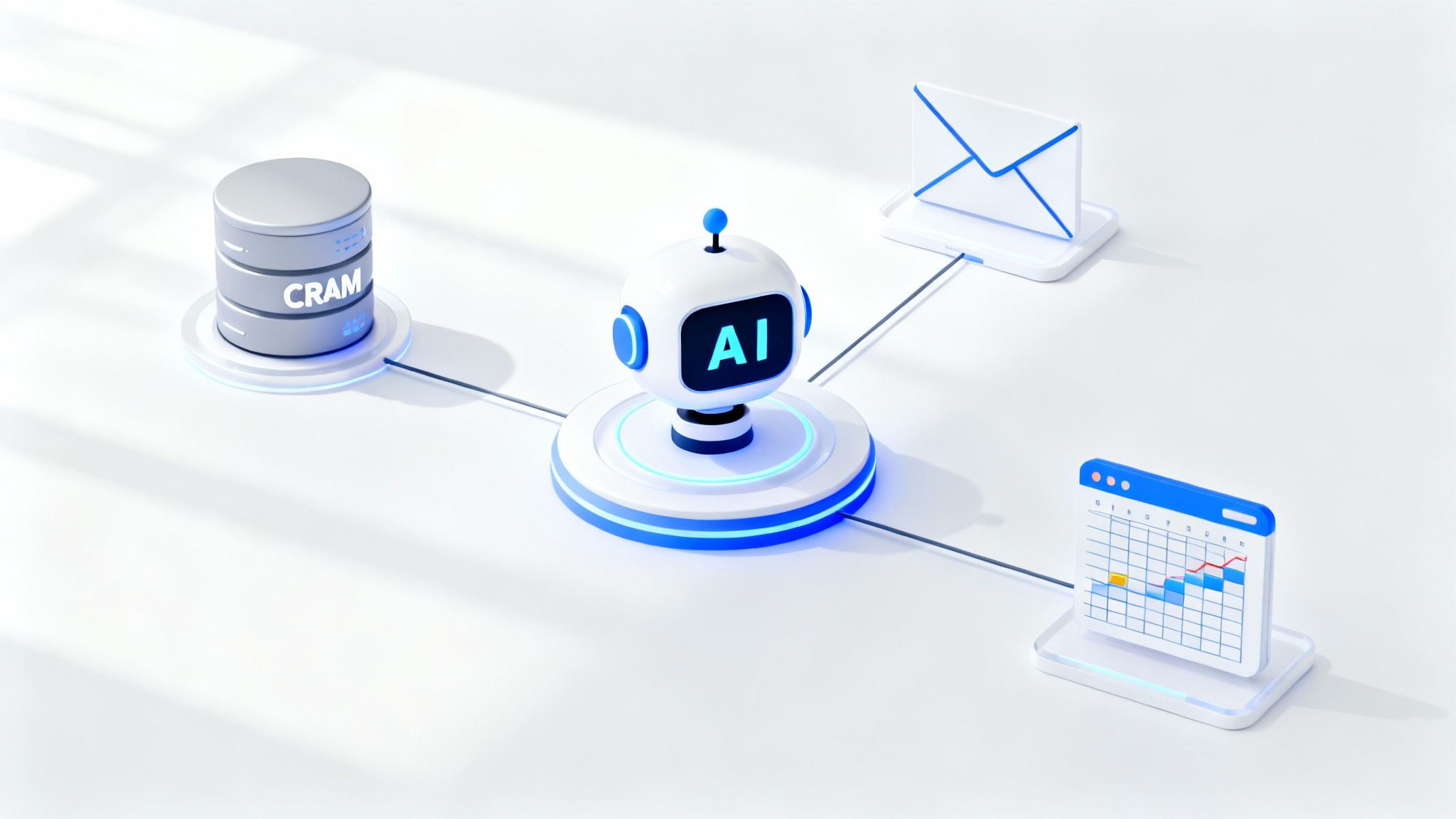To make sure you never miss a buyer enquiry with AI, the game has changed. It's time to move on from chasing up manual follow-ups and embrace a system that offers automated, 24/7 engagement. By setting up an AI assistant, you can guarantee every call gets answered and every lead is captured, turning what used to be missed opportunities into actual revenue.
The True Cost of a Missed Customer Enquiry
Let’s be honest, every unanswered call is more than just a single lost sale—it's a small crack in your business's foundation. The financial hit goes way beyond the initial transaction, causing ripple effects that can ding your reputation and stop growth in its tracks.
When a potential buyer calls, they're at their peak interest. A delay, or even worse, no response at all, sends a pretty clear message: their business isn't your priority. This doesn't just push them straight to a competitor; it chips away at the trust you're trying to build.
Beyond the Obvious Financial Loss
The damage doesn't stop with the lost revenue from that one enquiry. Unhappy prospects often share their bad experiences, which can lead to poor reviews and word-of-mouth warnings that scare off future customers. On top of that, you miss out on the valuable referrals a happy, engaged client would have sent your way.
Over time, these seemingly small misses really add up, creating a significant drain on your bottom line. To sidestep these issues, businesses need to proactively optimize customer experience with AI in SaaS and make sure every single interaction is captured.
This infographic paints a clear picture of how even a small number of missed enquiries can quickly turn into substantial weekly losses.

As you can see, missing just 20% of enquiries can easily result in thousands of dollars in lost revenue every single month.
The Australian Shift to AI Automation
A lot of Aussie businesses are now turning to AI to solve this persistent problem. It’s not just a trend; it's a strategic move. Research shows that by 2025, 50% of Australian businesses were regularly using AI, with adoption climbing at a rate of one new business every three minutes.
These businesses aren't just playing with new tech; they're seeing real results. On average, they're reporting a 34% revenue increase and 38% cost savings, mostly driven by the productivity gains that come with automation. This rapid shift is especially critical for businesses needing a reliable after-hours call answering service to ensure they truly never miss a buyer enquiry.
To give you a clearer idea of the difference this makes, let's break down the old way versus the new.
Manual vs AI Enquiry Handling: A Quick Comparison
| Feature | Manual Handling | AI-Assisted Handling |
|---|---|---|
| Availability | Limited to business hours | 24/7, 365 days a year |
| Response Time | Can be slow; depends on staff availability | Instantaneous |
| Lead Capture | Prone to human error; details can be missed | Automatic and accurate capture of every enquiry |
| Consistency | Varies between different staff members | Standardised, professional responses every time |
| Cost | High overhead for staffing, especially after hours | Lower, predictable subscription cost |
| Scalability | Difficult and expensive to scale | Easily handles fluctuating call volumes |
As the table shows, an AI-assisted approach isn't just a minor improvement—it’s a fundamental upgrade to how you can manage and grow your customer base. It's about working smarter, not harder.
Picking the Right AI Assistant for Your Business
Choosing the right tool is the first real step to make sure you never miss a buyer enquiry with AI. Let's be honest, not all platforms are built the same, especially when you're dealing with the unique demands of the Australian market. Your goal here is to find an assistant that feels like a natural extension of your team, not some robotic gatekeeper.
The most critical feature? It has to get local customers. This means its Natural Language Processing (NLP) needs to be properly tuned for Aussie accents, slang, and the way we talk. A system that fumbles this will just frustrate callers and lead to hang-ups.
Core Features for Australian Businesses
Beyond understanding the local lingo, there are a few other capabilities that are non-negotiable. You’re looking for an AI that creates a smooth experience for both you and your potential clients.
Here are the key features to put at the top of your list:
- 24/7 Availability: Your AI needs to be on the clock all the time, catching leads from night owls and early birds. No enquiry should ever fall through the cracks.
- Seamless CRM Integration: The magic happens when captured lead data is automatically pushed into your existing CRM (like Salesforce or HubSpot). This is essential for a slick, organised follow-up process.
- Customisable Scripts: You need to be in the driver's seat of the conversation. A good AI assistant lets you tweak greetings, set key qualifying questions, and guide the call flow so it matches your brand's voice.
Here’s a look at the clean, user-friendly interface from OnSilent, which makes the whole setup process a breeze.

This kind of simple design means you can configure all your call-handling rules without needing a degree in IT.
Getting Your AI Ready for Action
Once you've settled on a provider, the initial setup is usually pretty straightforward. You'll either connect your existing business number or get a new one to forward calls to. After that, it’s about crafting a welcome greeting that sounds professional but still approachable.
Your main job here is to define what a successful call looks like. You need to clearly outline the essential info the AI must grab—like the caller’s name, contact details, why they’re calling, and how urgent it is. This structured data is what makes your follow-ups so powerful.
If you want a deeper look at what a dedicated solution can do, you can explore the specifics of a leading AI answering service to see these features in practice. Nailing this initial setup is the foundation for an automated system that captures every single opportunity that comes your way.
Designing a Call Flow That Qualifies Buyers
Your AI assistant should be more than a fancy digital answering machine. Think of it as your most dedicated employee, a frontline qualifier working for you around the clock to sift through calls and find the real gems. The aim is to build a call flow that quickly sorts the serious, high-intent buyers from the tyre-kickers. This is how you make sure you never miss a buyer enquiry with AI that could be your next big sale.
The whole strategy kicks off with scripting smart, open-ended questions that get to the heart of why someone is calling. Instead of just grabbing a name and number, you want your AI to dig a little deeper.

This process is exactly what a top salesperson would do—it’s all about understanding the "why" behind the call. To really nail this, it helps to understand the core ideas in a good guide to lead qualification.
Crafting High-Intent Questions
The secret sauce is asking questions that uncover urgency, budget, and specific needs. You need to figure out what crucial info you need to decide if a lead is hot, warm, or just lukewarm.
For instance, a real estate agent could program their AI assistant with questions like:
- "Are you currently working with another agent, or just starting your search?"
- "What's your ideal timeline for moving into a new property?"
- "Have you already been pre-approved for a home loan?"
These questions work wonders. They instantly segment your callers. Someone who’s pre-approved with a tight moving deadline is obviously a much higher priority than someone who’s just scrolling through listings for fun.
The most powerful call flows use conditional logic. This means the AI's response and next actions change based on the caller's answers, creating a dynamic and personalised experience.
Using Conditional Logic to Route Calls
Conditional logic is the game-changer that turns your AI from a simple note-taker into a savvy frontline sales tool. It lets you create different paths for different types of enquiries, making sure your most valuable leads get your attention straight away.
Here’s how it might play out in the real world:
- High-Urgency Path: A caller mentions a burst pipe to a plumber or has a confirmed moving date for a real estate agent. The AI can be set to immediately try and transfer the call to a real person.
- Information-Seeking Path: If a caller is just doing some early research, the AI can offer to send them a digital brochure or schedule a demo for a later date, capturing their details to nurture them along.
- Low-Intent Path: For general questions, the AI can provide standard info from a script or point them to the FAQ page on your website.
This kind of automated triage system means your team's time is spent on activities that actually generate revenue, not filtering out low-quality leads. It's a structured way to guarantee no important buyer enquiry ever gets lost in the shuffle.
Hooking Your AI Up to Your Sales and Marketing Gear
Grabbing a lead is a solid start, but the real magic happens when you get that follow-up rolling instantly and without a hitch. This is where connecting your AI assistant to the sales and marketing tools you already use completely changes the game. The aim here is to set up a hands-off workflow that puts every single enquiry into action, without you needing to lift a finger.
Just think about how powerful that connection is for a moment. A new buyer enquiry comes in and is picked up by your AI assistant. Instantly, it can kick off a whole sequence of events: a new lead is created in your CRM, it’s assigned to the right person on your team, and it can even shoot off a personalised welcome email. It’s a completely hands-off system that ensures you never miss a buyer enquiry with AI.

Building Your Automated Workflow
The smartest and most common setups involve connecting your AI to the tools your team lives in every day. This builds a sturdy bridge between that first point of contact and all the follow-up that comes after, making your entire sales pipeline run a whole lot smoother.
Here are a few key integrations you should definitely consider:
- Your CRM System: Imagine caller details, the notes from their enquiry, and their urgency level all getting pushed straight into platforms like Salesforce or HubSpot. No manual entry needed.
- Email Marketing Platforms: You can automatically add new leads to specific nurture sequences in tools like Mailchimp or ActiveCampaign, all based on what they were asking about.
- Shared Spreadsheets: Even for a simpler setup, you can have all the captured lead info sent directly to a Google Sheet that your whole team can access.
This isn't just about making things a bit easier; it's a massive productivity booster. For Australian businesses, AI-powered tools that automate this kind of grunt work are a huge part of unlocking some serious economic benefits. In fact, AI is tipped to add up to AUD 115 billion to Australia's economy every year by 2030, mostly from these kinds of productivity gains. You can read more about the economic impact of AI in Australia if you're curious.
When you link these systems together, you create a reliable process where nothing falls through the cracks. Every lead gets captured, logged, and actioned straight away. This frees up your team to do what they do best—building relationships and closing deals, not getting bogged down in manual data entry.
Using AI Data to Sharpen Your Sales Strategy
Your AI assistant is doing a lot more than just taking messages. It’s quietly collecting a goldmine of business intelligence with every single call. When you tap into this data, you can stop just reacting to enquiries and start proactively shaping your sales and marketing for way better results. This is how you really make sure you never miss a buyer enquiry with ai that could turn into a sale.
Think about it. When you analyse the call transcripts and summaries, you'll start to see patterns. Are potential buyers constantly asking about a specific feature? Are they bringing up a competitor by name? This isn't just noise; it's direct feedback from the market, telling you exactly what matters to them.
Turning Those Insights into Action
This data is your secret weapon for making smarter decisions across the board. You can pinpoint exactly when your peak enquiry times are and staff up accordingly, or see which of your marketing campaigns are actually making the phone ring with high-value calls. It’s all about using real evidence instead of just guessing what might work.
This strategic shift is catching on fast. Recent findings show that by late 2025, AI adoption among small and medium Aussie businesses shot up to 41%. The main driver? A desperate need for more efficient ways to handle buyer enquiries. You can get the full scoop on these trends from Australia's AI adoption pulse on Theory of the Business.
Treat your AI assistant like a data-gathering partner. It gives you incredible insights into who your customers are and what they want, helping you make informed decisions that actually boost conversion rates and drive real growth. You're turning a reactive chore into a strategic asset.
At the end of the day, this data-driven approach helps you refine everything from your sales scripts to where you spend your marketing dollars. A great next step is to get familiar with the key communication metrics that show what's hitting the mark and what isn't. This constant feedback loop is what keeps you agile and perfectly in tune with what your market needs.
Your Top Questions About AI Enquiry Handling, Answered
Bringing any new tech into your business is a big decision, and it’s smart to have a healthy dose of scepticism. Most business owners I talk to have the same few worries: Will an AI assistant sound robotic? Is it going to break the bank? And what on earth happens when a caller has a really specific, human question?
Let's get straight into it and tackle these common concerns.
The fear of sounding like a robot is a big one, and honestly, a valid one based on the clunky old systems of the past. But modern conversational AI is a completely different beast. Forget those rigid, "press one for sales" menus. Today's assistants use natural language processing to understand what the caller actually wants, making for a conversation that feels surprisingly human and helpful.
Is This Going to Break My Budget?
Another major question is cost, especially for smaller businesses juggling every dollar. Hiring a full-time receptionist is a significant expense, no doubt about it. AI assistants, on the other hand, are usually a subscription service, which makes them far more affordable.
Think of it this way: you’re getting a team member who works 24/7 for a fraction of the cost. You can be sure you'll never miss a buyer enquiry with AI again, all for a predictable monthly fee without the overheads of another salary.
It's crucial to remember that the goal here isn't to replace your team, but to supercharge them. An AI assistant handles that first point of contact, filters the tyre-kickers from the genuine buyers, and captures all the key details. This frees up your human experts to do what they do best: have high-value conversations and close deals.
What About Really Complex Enquiries?
So, what happens when a caller throws a curveball with a complicated or super-specific question? This is actually where a well-designed system proves its worth. The AI is built to know its own limits.
When it comes across a query it can't handle, it doesn't just hit a wall. Instead, it can:
- Intelligently route the call to the right person or department.
- Schedule a call-back for a time when one of your human experts is free.
- Take detailed notes and fire off an urgent notification to your team.
This whole process ensures that even the trickiest issues are handled smoothly, without leaving a potential customer feeling frustrated or ignored.
Ready to see how an AI assistant can take the pressure off your team and capture every single lead? Let OnSilent handle the front line so you can focus on what really moves the needle. Explore our solutions and get started.

